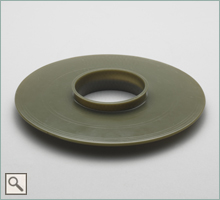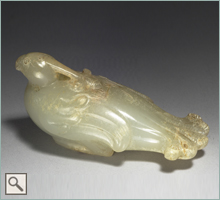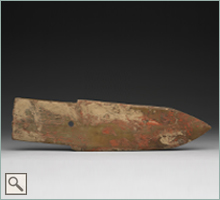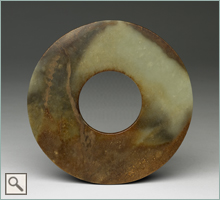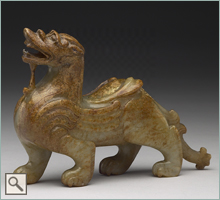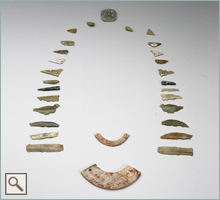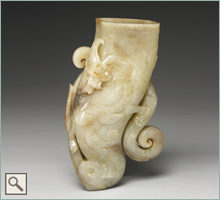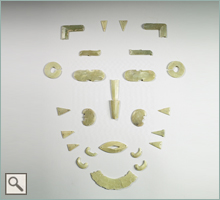From 2000 B.C.E. to 581 C.E., i.e. 4000 to over 1400 years ago, came and went six different dynastic periods in Chinese history: the Xia, the Shang, the Zhou, the Qin, the Han, and the Six Dynasties. During this long history spanning about 2500 years, except for the short-lived Qin and basically the disunited Six Dynasties, the royal houses of the other four major dynasties emerged in turn from the western and eastern parts of China Proper. They ascended to rule one after another, their power waxed and waned, and over the time their cultures assimilated with each other. By the Han dynasty, ethically and culturally they had come to integrate into an almost indivisible one, ushering in a new era of unification. It was also during this formative process that the superstitious belief in the "spiritual nature" of beautiful jade held by early people was gradually moralized under the influence of humanism and Confucianism as society advanced.
"Virtue" originally referred to "innate nature", a neutral and amoral concept. Back in the time remote, people believed that the Supreme God (called tian, Heaven, in the Zhou dynasty) sent divine creatures to endow life upon the ancestors of clans. The benefits of wearing jade carvings were therefore many-folded: it joined the vital force of beautiful jade with the magical power of divine creatures, accordingly enabled dialogues between deities and humans, and last but not least manifested the innate divinity of the wearer, i.e. "virtue". By the Eastern Zhou dynasty, however, the original aspects of jade ornaments had been long forgotten; Confucians took a more rational view at the qualities of beautiful jade and associated them with the fine "virtues" of a junzi figure: benevolence, rectitude, wisdom, courage, and integrity. Junzi, initially meaning "rulers", also transformed in the Eastern Zhou dynasty into "gentleman-intellectuals of high virtues".
Over the long span of time, the pairing of Gui-and-Bi jades by the Zhou people became the core of Chinese jade ritual. The Han royal house came from Pei County in the Jiangnan region where the ancient Yue custom of "Jade Burial" originated; the practice reached its acme during the dynasty. Foreign elements such as bixie (warding off evils) amulets and horn cups, reaching China, also adopted jade carving as the medium to exhibit their beauty and took up additional mystic aura that was distinctively Chinese.
Virtuous as Jade
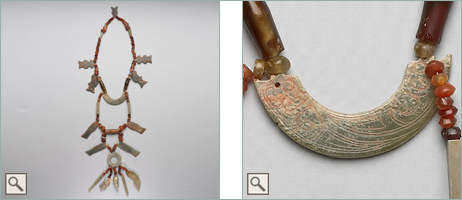
| Huang and Pei set Western Zhou dynasty c. 1046-771 B.C.E. |
Jade Huang Ornament of the Pei set |
Ritual Jades of the Xia and Shang Dynasties
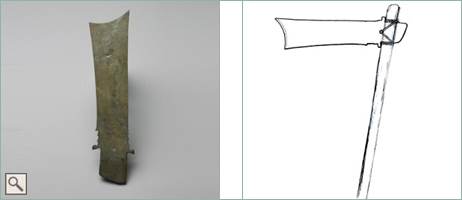
| Jade Yazhang Blade Xia dynasty c. 2070-1600 B.C.E. L. 38.1 cm W. 9 cm D. 0.8 cm |
Diagram of a Yazhang with wooden handle restored |
Ancestral Tablet and Turtledove Staff
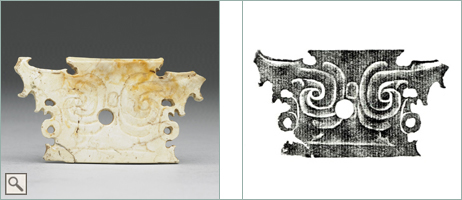
| Jade article carved with ancestral-mask pattern Late Shijiahe Culture c. 2100-1800 B.C.E. H. 3.5 cm L. 6.5 cm |
Rubbing |
The Establishment of the Gui-Bi Ritual
The All-Powerful Jade Bi Disc
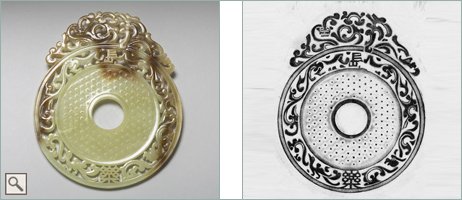
| Bi Disc of Chang Le (forever joyful) Eastern Han dynasty 25-220 C.E. H. 16.55 cm Diam. 13.47 cm |
Rubbing |
Realism and Mysticism
Jewelry of the Nobility: Jade and Jade-like Stone
Early to Early-mid Western Zhou Dynasty
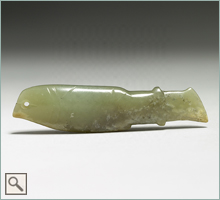 Pei Ornament in the shape of fish
Pei Ornament in the shape of fishLate Shang to early Western Zhou dynasties
c. 1300-977 B.C.E.
L. 5.1 cm W.1.2 cm D. 0.6 cm
Jewelry of the Nobility: Jade and Jade-like Stone
Mid-late Western Zhou Dynasty to Late Spring and Autumn Period

| Jade Necklace Late Western Zhou dynasty c. 877-771 B.C.E. |
Jade shield-shaped plaque of the necklace | Jade girdle-shaped plaque of the necklace |
Jewelry of the Nobility: Jade
Warring States Period to Eastern Han Dynasty
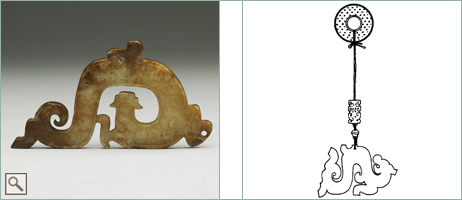
| Pei Pendant with chi tiger pattern Warring States Period c. 475 -141 B.C.E. |
Diagram of a jade set with thread from Warring States Period Sources of diagrams: archaeological reports of Zhongzhoul. |
The Changing Pei Ornament Sets
The Six Dynasties to Tang Dynasty
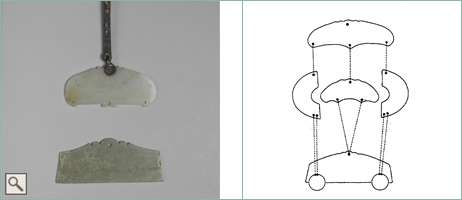
| Remains of a Pei Ornament set (one heng and one chong) Late Northern and Southern Dynasties c. the end of 6th Century |
Eastern Jin Period Diagram of Pei Ornament set Sources of diagrams: archaeological reports of Gaosong Tomb |
Jade Vessels and Other Carvings
Ornamental Jades
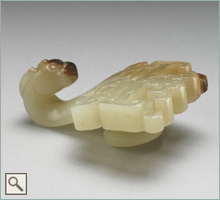 Jade Belt Hook
Jade Belt HookWarring States Period to
early Western Han dynasty
c. 475-141 B.C.E.
L. 4.4 cm W. 3.0 cm
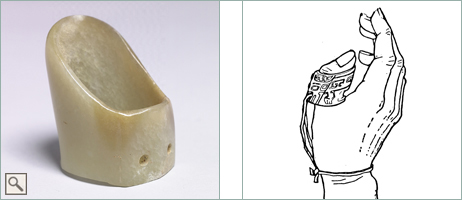
| Jade She Thumb Ring Late Western Zhou dynasties c. 1300-771 B.C.E L. 4 cm W. 3.4 cm H. 2.8 cm |
A late-Shang she thumb ring and how it is worn drawing from the Tomb of Fuhao |
Jade Weaponry and Jade-Ornamented Swords
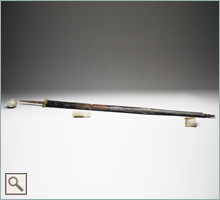 Jade Ornamented Sword
Jade Ornamented SwordWestern Han dynasty
206 B.C.E.-8 C.E
Iron sword blade has been attached to
lacquered scabbard
The ancient iron blade is stuck inside
the lacquer sheath, complete with
four jade ornamental fittings:
pommel, cross-guard, slide, and
chape.
L. 89.5 cm
Funerary Jades




